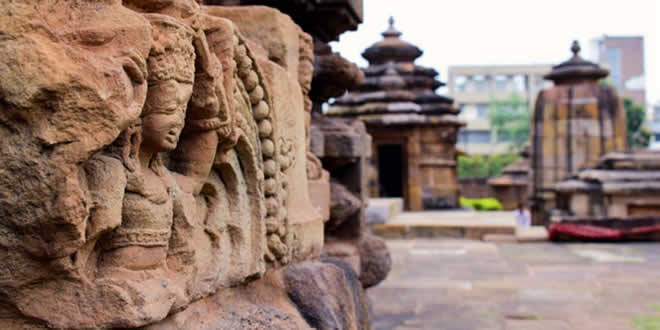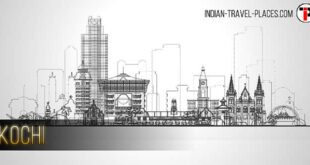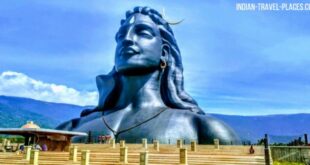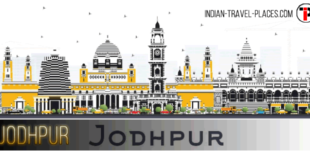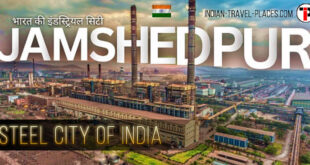| Name: | Bhubaneswar – Temple City |
| Location: | Capital City of Odisha State, India |
| Climate: | Summers: 450 C (Max), 300 C (Min) | Winters: 280 C (Max), 170 C (Min) |
| Best Time to Visit: | October to Mid-March |
| Nearest Airport: | Biju Patnaik Airport |
| Railway Station: | Bhubaneswar Railway Station |
| Must Visits: | Lingaraj Temple, Lakshmanesvara Temple, Parasuramesvara Temple, Khandagiri & Udayagiri, Dhauli Giri, Cactus Garden, IG Park |
| Language Spoken: | Hindi, Odia (Oriya), English |
| STD Code: | 0674 |
Bhubaneswar is one of the ancient cities of India, located in the Eastern part of India and on the south-west of the Mahanadi River. This city is the capital of Indian state of Orissa (also known as Odisha). It features more than 600 Hindu temples, exhibiting the continuum of ancient Kalinga Architecture. This explains as to why it is often referred to as Temple City of India, Temple Town or Cathedral City of India. Bhubaneshwar is sited at an altitude of 45 m above the sea level. It has a tropical wet and dry climate with extremely hot and wet summers (April to May), cool winters (October to March). The place receives an annual rainfall of 1540 mm. October to mid-March poses as the best time to visit this city of temples. Along with Puri and Konark, Bhubaneshwar forms the “Swarna Tribhuja” (the Golden Temple Triangle) of Eastern India and is thus, visited by thousands of visitors daily.
This ancient city has witnessed many dynasties, empires and historical events in its magnificent history of 2000 years, beginning from 2nd century BCE (Chedi Dynasty). Thus, it has been known by different names such as Toshali, Kalinga Nagari, Nagar Kalinga, Ekamra Kanan, Ekamra Khetra, all throughout. One of the most historic and crucial events, the Kalinga War occurred here in 261 BC, by The Great Ashok. The main history of Bhubaneswar can be divided into two phases, ancient city history (since 2000 years) and modern city history. The modern city of Bhubaneshwar was designed by a German architect, Otto Konigsberger, in the year 1946. It was then that the city was formally launched as the capital of Orissa on April 13, 1948. Today, it is the largest, cleanest and greenest city of Orissa and also a prominent economic and religious centre of the nearby region. Bhubaneshwar has an effective transport system which makes it easily accessible by all modes of transport including railways, roadways and airways.
Bhubaneswar is named after Hindu God, Lord Shiva, who is also known as ‘Tribuhuvaneswara’ which literally means the ‘Lord of Three Worlds’. Other than Hindus, this city is a significant pilgrimage centre for Buddhists and Jains as well. The most famous ancient temples of Bhubaneswar are Lingaraj Temple, Lakshmanesvara Temples, Parasuramesvara Temple, Svarnajalesvra Temple, Muktesvara Temple, Rajarani Temple, Vaital Temple, Brhamesvara temple, Meghesvara temple, Vaskaresvara Temple, Ananta Vasudeva Temple, Sari Temple, Kapilesvara Temple, Markandesvara Temple, Yamesvara Temple, Chitrakarini Temple and Sisiresvara Temple. Some of the other tourist places that you should not miss to visit, whilst in Bhubaneswar, are Khandagiri & Udayagiri (Jain Heritage), Dhauli Giri (Buddhist Heritage), Cactus Garden, IG Park, Orissa State Museum, Handicrafts Museum and Tribal Museum.
Best Time To Visit Bhubaneswar
Wish to explore the historical relics, architectural brilliance, religious sanctums and the scenic seascape of Orissa? If yes, then rush to the capital city of Orissa, Bhubaneswar and experience the spectacular culture of the land. A boisterous city infused with bucolic spirit and a contemporary way of life, a trip to Bhubaneswar is like a deep dive into the magnanimous culture of the state. Fondly dubbed as the city of temples, Bhubaneswar houses the remains of nearly 50 odd stone temples that give you a glimpse of the medieval temple architecture of the place. Visiting this city not only takes you through a spiritual ride but also helps you fathom the vast history and rich craftsmanship of Orissa. With a beautiful amalgam of mind-blowing architecture and rural spirit, the place makes for an ideal tourist destination for the vacationists. Although no season and time can downplay the attraction of the temples here, it is always good to visit the place at the right time of the year for a convenient stay. If you intend to visit Bhubaneswar anytime soon, then knowing the best time to visit the city will help. Trail the following write-up to know when to go to Bhubaneswar and enjoy your stay there.
When To Go To Bhubaneswar
Weather
Surrounded by a dense canopy of thick forests such as Chandaka and Nandankanan, Bhubaneswar is flanked with green surroundings and stunning environs. Just like all other cities in Orissa, Bhubaneswar too experiences tropical climate and is subjected to the extremities of the seasons. Summers in the city, extending from March to May, are extremely hot with temperature shooting beyond 450 C. Because of the scorching heat, this season is unfit for a day’s excursion or long trips. The monsoons here, which persists from June to September, is marked by torrential rain. Although the weather is quite pleasing during this time, visiting Bhubaneswar during monsoons isn’t a great idea with heavy rains, water logged roads and uprooted trees adding to the woes of the city. The winters here, which lasts from October to March, brings in pleasant weather, with the temperature shuttling between 150 C max to 070 C min.
Best Time To Explore Bhubaneswar
Although there is no specific season to explore the splendor of the place, to enjoy your trip to the fullest, it is best to visit the place anytime between October to March. Post-monsoon, the city looks extremely beautiful with dulcet greenery and idyllic weather adding to its attractions. Apart from the agreeable weather conditions, a string of attractions like the Lingaraj Temple, Peace Pagoda, Mahavir Jina, Odissi dance and the famous ‘Ikat’ weaves beckons every curious traveler to come and explore the bliss of the city. What’s more, popular celebrations like ‘Shiva Ratri’, ‘Khandagiri Mela’, ‘Ashokastami’, ‘Ramanavami’, ‘Jhamuyatra’, and ‘Anla Navami’ further adds to the attraction of the city. No words are enough to describe the beauty of these festivities. If you happen to be in Bhubaneswar during any of the festive seasons, don’t miss the chance to be a part of its jubilation.
Things To Do
A trip to the temple city of Bhubaneswar will take you through a number of ancient shrines that are admired for their artistic beauty and historical background. The Lingaraj temple, one of the must visit temples in Bhubaneswar, situated on the banks of Bindu Sagar Lake, gives a sneak-peek into ancient India and its architectural elegance. Some of the other noted attractions of the place is Vaital Deul Temple, Mukhteshwara Temple, Brahmeshwara Temple, Parasurameswar Mandir etc. To know more on the culture and historical background of the city, you must make a quick jaunt to the Orissa State Museum, which houses finest collections of artifacts, manuscripts and other relics. Shopping is other activity that you are likely to enjoy here. From handicrafts, stone carvings and wonderful paintings to cotton cloths, silk saris and artistic jewelry, Bhubaneswar promises a wonderful trip to its visitors.
History Of Bhubaneswar
The history of Bhubaneswar exudes art, life and beliefs of different ancient civilizations that existed within the region, which explains why the city has been forever of enormous interest to the historians, epigraphists and archaeologists alike. The city was once home to more than 7000 shrines. However, today, only a small number of shrine remains. Bhubaneswar combined with Puri and Konark forms the famous ‘golden triangle’ of Orissa. Bhubaneswar’s history can be broadly classified into two categories — ancient and modern. According to a detailed historical study, the city was once home to the Chedi Kingdom before it became the backdrop for the famous Kalinga War during the Mauryan Empire. The city was restored to its former glory by the descendants of the Chedi family who recaptured the throne. However, in course of time, the region was subjugated by powerful Mughal and Maratha rulers before it was restored as a part of the Bengal Presidency. Read the article to know more about Bhubaneswar’s history.
Bhubaneswar History
Ancient Period
The history of Bhubaneswar takes you back to the 2nd century BC to the Chedi dynasty. The rulers of the Chedi dynasty were the first to establish their kingdom in Sisupalgarh where Bhubaneswar is presently located. Although the city was founded by the Chedi kings, it remained unknown to the world for a long time. It was only in the 3rd century BC that the place rose to prominence. It was during this period that the famous Kalinga War took place between the Mauryan Empire and the state of Kalinga. Chedi Empire was almost on the verge of decline when King Kharavela of the Chedi dynasty reinstated Kalinga back to its former glory, post the Kalinga war. Kharavela was a patron of architecture, religion and economics. During his period, several temples were built and trade routes were established to Thailand, Sri Lanka, Myanmar, Vietnam, Sumatra, Bali and many other nations. Just like Ashoka who adopted Buddhism, Kharavela embraced Jainism. That is why most of the structural designs that you see in this region seems to be inspired from the Jain style of architecture. Udayagiri and Khandagiri Cave and Hathigumpha inscription are some of the best examples of the structural work of the bygone Chedi era. In the following years, the city became a big-name for its innumerable shrines and was soubriqueted as ‘the temple city’.
Medieval Period
During the medieval period, Bhubaneswar saw the dominance of various religious sects. With the introduction of Jainism and Buddhism in the province, the city became deeply involved in matters of philosophy. However, with time, the principles of Jainism and Buddhism began to fade and gave way to Brahmanism and Vaishnavism in the region. It was during this time, when Bhubaneswar reached the pinnacle of its religious status. During the 7th and the 12th century, the city rose to prominence because of its carvings, sculptures and architectural designs. With the invasion of the Mughal rulers in the 15th century on the eastern side of the continent, many of these magnificent sandstone compositions were destroyed and plundered.
British India
During the 16th century, the province was repressed by the mighty rulers belonging to the Mughal dynasty. The Hindu rulers proved to be submissive and failed to overthrow the Muslim rule in the district. The advent of the next century brought about the dominance of the Maratha Empire in the country. Parts of coastal Orissa were predominately captured and ruled by them. In the 18th century, the place was overpowered by the British East Indian Company. With the entire region falling into the hands of the English, the state of Orissa, otherwise known as Odisha, underwent some administrative changes. In 1936, the place became a separate entity and Cuttack became the capital of Orissa.
Modern History
With Cuttack being the capital of the state, the province was subjected to many natural calamities and also suffered from space restrictions, which in turn hampered the growth and development of the city. As a result, the capital was shifted to Bhubaneswar in the year 1948, just after India gained its independence from the British. Otto H. Konigsberger, a German architect, was invited to plan the new city of Bhubaneswar. On 13th April 1948, the new city of Bhubaneswar was officially declared as the new capital of Orissa. Just like Jamshedpur and Chandigarh, Bhubaneswar was also planned to provide new and improved amenities to its people.
How To Reach Bhubaneswar
Sobriqueted as the ‘Temple City of India’, the ancient city of Bhubaneswar has managed to retain much of its antediluvian charm, thanks to the people here who have successfully upheld this cradle of culture with great aplomb. Away from the usual noisy, hectic and congested city life, the artistry, architecture, and the beautiful amalgam of bucolic and urban has never really failed to intrigue its visitors. What is even more awe-inspiring about this place is its nonpareil customs and culture that is well reflected in its temples and architectures that testify the royal legacy of the place. Being a temple city, Bhubaneswar is flocked with tons of devotees throughout the year, which has made the city one of the most thriving pilgrimage destinations in India. Adding to the glory of the city is its fine museums and art galleries that showcase the grandeur of the city. Traveling to this historical and cultural junction of Orissa is not difficult as the place is well connected by air, road and rail. If you plan to travel to the city, then going through the article below will give you all the necessary information on how to reach Bhubaneswar.
Traveling To Bhubaneswar
By Air
The Biju Patnaik Airport, located about 4 km away from Bhubaneswar, connects the city to almost all the major cities of India including Delhi, Chennai, Varanasi, Kolkata, Nagpur and Vishakhapatnam. Indian Airlines provides regular flights to the city. Some of the other domestic airlines operating from Bhubaneswar are Jet Airways, Air Deccan, Air Sahara, Kingfisher and SpiceJet. Serving as the only major airport in Orissa, the Biju Patnaik airfield attracts huge crowd. Thus, to avoid the unwanted last minute glitches, it is advised to book your tickets in advance. For the convenience of the passengers, the airport offers amenities like well-stocked eateries and cafes that provide quality food and excellent service.
By Rail
With several trains passing through Bhubaneswar, the railway station of the city serves as the gateway of Orissa. A large number of trains, including several super fast express connects Bhubaneswar to the cities of Kolkata, Delhi, Chennai, Hyderabad, Guwahati, Bangalore, Mumbai and Ahmedabad. Even though the railway station remains crowded with commuters, passengers, porters and vendors all the time, nevertheless it is known for its cleanliness and service. For the convenience of its passengers, the city has introduced computerized ticket booking.
By Road
With well-maintained national highways, Bhubaneswar is connected to almost all the major cities of India. Several state government and private buses further connects the city to the neighboring cities of Bhubaneswar. The new bus stand located at Baramunda, 6 km from the city, provides several inter-state buses. From AC services to semi-deluxe buses, tourists can opt from a host of services to suit their pocket and convenience. Apart from the buses, you can opt for private taxis and other vehicles. To help you in exploring the city, there are a number of auto-rickshaws and public services, which operate at a nominal price.
Places To Visit In Bhubaneswar
This vacation, give the beaches and the hills a skip and spend a few days in the ‘city of high spires’, Bhubaneswar, the capital city of Orissa. With an interminable history of almost 2000 years, Bhubaneswar is somewhat like a cradle of culture, a melting point of the present and the past. Unlike other conurbation fazed by the claws of urbanization, Bhubaneswar upholds its bucolic charm and modern attractions with great poise. Hurled on the eastern shores of India, this sprawling city swathed with forested hills, monumental spires and age-old monuments makes for a top-notch traveler’s destination. Come to Bhubaneswar to explore its sensuous Odissi dance, splurge in exquisite ‘ikat’ weaves and amazing Pipli applique works, take a trail down the secular shrines and spend some amazing days in this ancient land. Peppered with number of impressive shrines, the ‘temple city’ perfectly compliments its historical background. To know more about the major tourist attractions in Bhubaneswar, go through the article below.
Tourist Attractions In Bhubaneswar
Muktesvara Temple
Muktesvara temple, one of the most striking attractions in Bhubaneshwar, is known for its stunning structure modeled after Kalinga School of temple architecture. Dedicated to Lord Shiva, the temple houses a number of carved figures from the scenes of ‘Panchatantra’. Several additions made to the temple over the years have given a dramatic makeover to the building. Hence, it’s no wonder why the place is today popular as ‘Gem of temple architecture’.
Parasurameswara Temple
Parasurameswara Temple built in 650 A.D. is the oldest existing temple in Bhubaneswar. Dedicated to Lord Shiva, the temple is a true specimen of Oriyan architecture. Decked with extensive stone sculptures of various animals, floral designs and carved images of Hindu gods like Ganesh, Shiva, Vishnu, Parvati, Muruga and many others mythological deities. Apart from these, the images on the walls of the temple narrate the stories from legends. Other major attraction of the temple is ‘one thousand Lingas’ placed in the corner of the temple. If you are interested in ancient sculptures and architectures, then this place is a must visit for you.
Raj Rani Temple
Known for its wonderful red and gold sandstone architecture, the Raj Rani temple is one of the most renowned tourist attractions in Bhubaneswar. Dedicated to Lord Brahma, the temple attracts people by its elaborately carved figures and colorful interiors, which are simply stunning.
Lingaraj Temple
The Lingaraj temple belonging to 11th century is one of the finest temples in India, which is admired for its Oriyan architecture and skilled craftsmanship. The massive structure of the temple is covered with huge walls and is surrounded by many small shrines. The beautifully and elegantly carved tower of the temple is one of the major attractions of the structure.
Ekamra Haat
Ekamra Hatt spread across 5 acre plot that showcases the cultural diversity of the state through its handicrafts, handlooms, regional clothing’s and delicious cuisine. The lush green environ of the place not only displays the rich culture of Orissa but will also sell ethnic goods at a much reasonable price. One of the major attractions of the place include open-air theater, food stalls, artisan rest rooms, information centre and lily pond with water pond.
Museum Of Man
Museum Of Man is one of the major attractions in Bhubaneswar. Known for its wide collection of tribal culture and art, the museum enriches your knowledge through its interesting displays. Some of the noted attractions of the museum is tribal dress, weapons, jewelry, musical instruments and several pictures.
Pathani Samanta Planetarium
If you are interested in astronomy or intrigued by the celestial bodies, then a visit to Pathani Samanta Planetarium of Bhubaneswar would get you up, close and personal with the working of heavenly bodies. Here, you can indulge in activities like night sky watching, audio visual programs and several seminars that would take you into the interesting world of astronomy. The well maintained library within the planetarium provides number of books on various aspects of science and technology. You can enjoy the shows of the planetarium on any day except on Mondays.
Shopping In Bhubaneswar
Apart from its temples and copious historical attractions, Bhubaneswar is wadded with myriad shopping destinations and marketplaces that sells almost everything, right from local crafts to swanky souvenirs to interesting curios and lots more. The souvenirs of this place proudly showcases the rich artistic heritage of the land. Some of the most popular picks of the place that are worth splurging in are appliqu’ works, locally known as Chandua, sculptures of gods and goddesses, silk fabrics, ‘ikat’ weaves, handcrafted items and more. Bhubaneswar city has its fair share of swanky malls and street stalls. Though the malls and huge shopping centers are good for hanging out and browsing along, it’s the quaint little stalls and well-maintained emporiums that remains mostly crowded. During the peak tourist seasons and warm evenings, the shopping places become jam-packed with foreigners and curios shoppers. Though Bhubaneswar can be visited round the year, the ideal time to hit this place is between October and February when the weather is more gratifying. To know the best shopping places in Bhubaneswar, scroll down the article further.
Shopping Places In Bhubaneshwar
Utkalika
Utkalika, situated near Sahid Nagar, is a one-stop shop for buying genuine and exotic Orissa handicrafts and artifacts. A wide array of gorgeous and delicate looking products such as appliqu’ works, palm leaf engravings, stone carvings, tribal jewelries, pattachitras, masks and toys of papier mache can be found and purchased from here. The other popular handicraft emporiums to be visited in Bhubaneswar are Chakadola Handicrafts Co Op Society Ltd, U P State Handlooms Corporation, Orissa Handicrafts Corpn Ltd, Nibedite Beauty and Handicraft among others.
Mahalaxmi Textiles
To buy silk and cotton textiles, head out to shops like Mahalakshmi Textiles that is stocked with interesting apparels. Both men and women can shop here for T shirts, saris, pants, salwar suits and other related items. Situated near Sambit Palace, Ashok Nagar, Mahalkashmi Textiles is open on all the days. Also, check out the other sari shops like Bindu Saree Shop, Gayatri Garment, Mahak Saree Collection and Mahalaxmi Saree Mahal.
Haryana Handlooms
Haryana Handloom that is located in Ashok Nagar is a must visit place for every shopaholic. Furnishing items like draperies, pillows, cushions, carpets, rugs, curtain clothes and lots more are on display here. Not just tourists, even local people often flock here to buy these items. What makes Haryana Handlooms different from other places is the unique design and quality of the fabric used in creating the products.
Orissa Art And Craft
Orissa Art and Craft located near Panth Nivas, Lewis Road is good place to browse through the valuable collection of metallic works and silver filigree products that are locally known as Tarakashi. Usually, silver filigree products are tad bit expensive as they are made mostly from pure silver. Also, besides these, there are eye-catching appliqu’ works that are hot favorite among tourists.
Konark Wood Products
Konark Wood Products located in Acharya Vihar is filled with enticing wooden products such as wood sculptures, image of gods and goddesses, wood work of various animals like horses, elephants and peacocks etc.. Also, housed here are articles like toys masks, and carved boxes. These items are perfect for gifting your loved ones and make for perfect souvenirs.
Ekamra Haat
Ekamra Haat that can be found in the heart of the Bhubaneswar city is a great place to buy some authentic Orissa handicrafts like Patta Chitra, Sambalpuri Sari, Chandua of Pipli, sand art, metal work, stone carvings and many more. The ambience and surroundings near Ekamra Haat is interesting and a good place to hang around with friends. If you feel worn out after exhaustive shopping, there are food stalls lined up here that serve traditional foods like chakuli pitha, chhenna poda and mutton curry. Ekamra Haat (the craft village) is open on all the week-days from 10 AM to 10 PM.
 ITP Indian Travel Places: Food, Travel, Tourism Business Events and Trade Shows
ITP Indian Travel Places: Food, Travel, Tourism Business Events and Trade Shows
